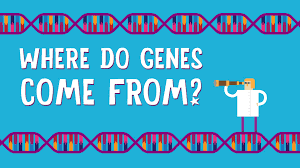(单词翻译:单击)
You have about 20,000 genes in your DNA.
在你的DNA里大约有两万个基因。
They encode the molecules that make up your body, from the keratin in your toenails,
它们编码了组成你身体的各种分子,从组成你脚趾甲的角蛋白,
to the collagen at the tip of your nose, to the dopamine surging around inside your brain.
到你鼻尖的胶原蛋白,再到活跃在脑部的多巴胺。
Other species have genes of their own. A spider has genes for spider silk.
其他的物种有他们自己的基因。蜘蛛有蜘蛛丝的基因。
An oak tree has genes for chlorophyll, which turns sunlight into wood.
橡树有可以将阳光转化为木头的叶绿素。
So where did all those genes come from? It depends on the gene.
但是,这些基因都是从哪里来的呢?这还是要取决于基因。
Scientists suspect that life started on Earth about 4 billion years ago.
科学家们猜测地球上的生命大约起源于40亿年前。
The early life forms were primitive microbes with a basic set of genes for the basic tasks required to stay alive.
较早的生命形态是原始微生物,只有一套用于维持生命基本功能的简单的基因。
They passed down those basic genes to their offspring through billions of generations.
它们把这些基因传给后代,传播了数亿代。
Some of them still do the same jobs in our cells today, like copying DNA.
一些基因还在细胞里做同样的工作,比如说复制DNA。
But none of those microbes had genes for spider silk or dopamine.
但是其中没有一个是编码蜘蛛丝或者多巴胺的。
There are a lot more genes on Earth today than there were back then.
现在地球上的基因要远远多于从前。
It turns out that a lot of those extra genes were born from mistakes.
它们大多是通过错误诞生的。
Each time a cell divides, it makes new copies of its DNA.
每一次细胞分裂的时候,都会复制自己的DNA。
Sometimes it accidentally copies the same stretch of DNA twice.
有时它会意外的复制两次同样的DNA段。
In the process, it may make an extra copy of one of its genes.
在这个过程中,有可能会产生多余的基因。
At first, the extra gene works the same as the original one.
起初,多余的基因和原来的基因有着相同的功能。
But over the generations, it may pick up new mutations.
但是在代代相传中,它有可能会产生新的基因突变。
Those mutations may change how the new gene works, and that new gene may duplicate again.
这些突变有可能会改变新基因的功能,然后新的基因也许会被再一次的复制。
A surprising number of our mutated genes emerged more recently; many in just the past few million years.
有相当一部分我们突变的基因是最近才出现的,很多是仅仅在数百万年前产生的。
The youngest evolved after our own species broke off from our cousins, the apes.
最年轻的基因从人类的表亲,人猿进化而来。
While it may take over a million years for a single gene to give rise to a whole family of genes,
虽然说从单个基因到一族基因的转变也许需要超过一百万年,
scientists are finding that once the new genes evolve, they can quickly take on essential functions.
科学家们发现,一旦新的基因进化了,他们很快就可以承担起必要的功能。
For example, we have hundreds of genes for the proteins in our noses that grab odor molecules.
举个例子,有数百个基因编码了鼻子中用来捕捉气味分子的蛋白质。

The mutations let them grab different molecules, giving us the power to perceive trillions of different smells.
这样的突变让他们可以抓到不同的分子,让我们拥有可以识别数万亿种不同味道的能力。
Sometimes mutations have a bigger effect on new copies of genes.
有些时候突变对复制的基因会带来更大的影响。
They may cause a gene to make its protein in a different organ,
他们也许会让一个基因在不同的器官中生产蛋白质,
or at a different time of life, or the protein may start doing a different job altogether.
或者是发生在生命中不同的时间段,或者说生产的蛋白质会一起从事不同的工作。
In snakes, for example, there's a gene that makes a protein for killing bacteria.
用蛇来举例,它体内有一种专门杀死细菌蛋白质的基因。
Long ago, the gene duplicated and the new copy mutated.
很久之前,这基因复制了并且产生了基因突变。
That mutation changed the signal in the gene about where it should make its protein.
这个突变改变了基因上决定在哪个部位生产某种蛋白的信号。
Instead of becoming active in the snake's pacreas, it started making this bacteria-killing protein in the snake's mouth.
这种能杀死细菌的蛋白质没有在蛇胰腺中被激活,取而代的是,它们被用在了蛇的嘴里。
So when the snake bit its prey, this enzyme got into the animal's wound.
当蛇咬到猎物的时候,这种酶就会渗透到动物的伤口里。
And when this protein proved to have a harmful effect, and helped the snake catch more prey, it became favored.
并且当这种蛋白质被证实是有毒的,可以帮助蛇捕捉到更多的猎物,这种蛋白就被保留下来了。
So now what was a gene in the pancreas makes a venom in the mouth that kills the snake's prey.
所以从前在胰腺中的基因现在成了嘴中用来杀死猎物的毒液。
And there are even more incredible ways to make a new gene.
新的基因还能通过更难以置信的方式产生。
The DNA of animals and plants and other species contain huge stretches without any protein coding genes.
动物,植物以及其他物种的DNA,含有一大部分不编码蛋白质的基因片段。
As far as scientists can tell, its mostly random sequences of genetic gibberish that serve no function.
据科学家所知,这些大多是无意义无功能的随机组合。
These stretches of DNA sometimes mutate, just like genes do.
这些DNA片段有时候会像基因一样产生突变。
Sometimes those mutations turn the DNA into a place where a cell can start reading it.
有时候这些突变可以变成标志着基因序列开始的起点。
Suddenly the cell is making a new protein.
突然间,该细胞就可以产生新的蛋白质了。
At first, the protein may be useless, or even harmful, but more mutations can change the shape of the protein.
期初,这些蛋白质也许是无用的甚至是有害的,但是更多的基因突变可以改变蛋白质的形状。
The protein may start doing something useful,
该蛋白质也许会发挥出一些有意义的功能,
something that makes an organism healthier, stronger, better able to reproduce.
有时它会让一个器官更加的健康,强壮,更好的繁殖后代。
Scientists have found these new genes at work in many parts of animal bodies.
科学家们发现这些新的基因工作在动物身体中的各个部分。
So our 20,000 genes have many origins, from the origin of life, to new genes still coming into existence from scratch.
所以我们两万个基因有许多种起源,从生命的起源到刚开始存在的新基因。
As long as life is here on Earth, it will be making new genes.
只要地球上有生命的存在,就会有新的基因产生。


